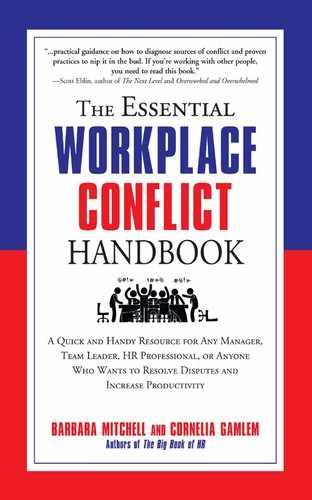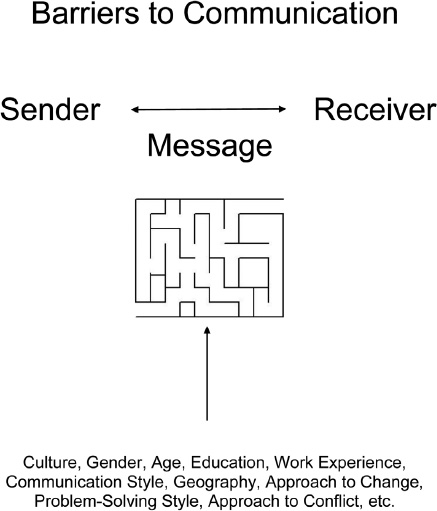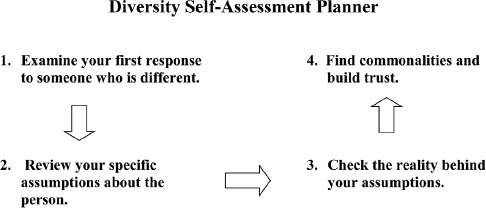APPENDIX
ADDITIONAL RESOURCES
Seven Dimensions of Culture
(The following table on pages 206, 207, and 208 is based on the model developed by Fons Trompenaars and Charles Hampden-Turner as published in their book, Riding the Waves of Culture.)
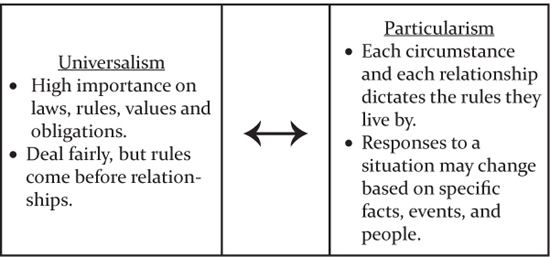
The Individual vs. The Group

How Far People Get Involved
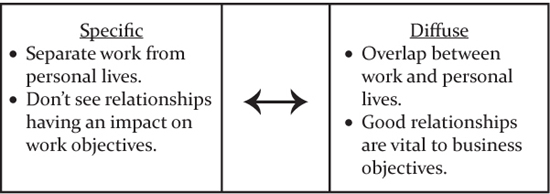
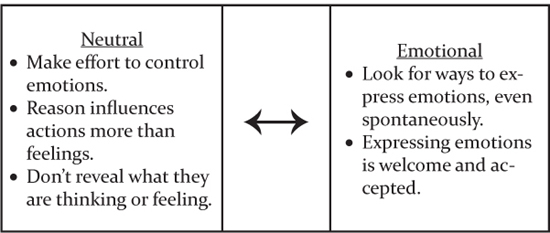
How People View Status
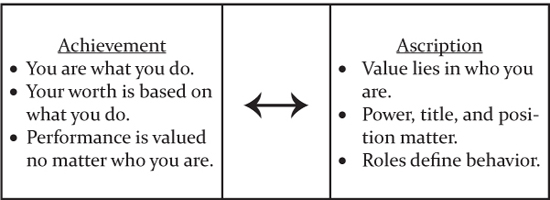
How People Manage Time

How People Relate to Their Environment
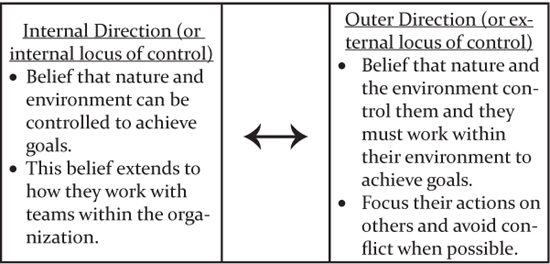
Examples of Team Conflicts
Any of these can result in team members being in conflict with other team members.
![]() Unclear team purpose—why are we together and what are we expected to accomplish?
Unclear team purpose—why are we together and what are we expected to accomplish?
![]() Unclear roles on the team. For example, who is the team leader?
Unclear roles on the team. For example, who is the team leader?
![]() Poor choice of a team leader.
Poor choice of a team leader.
![]() Unproductive team meetings.
Unproductive team meetings.
![]() Disruptive behavior that is unresolved.
Disruptive behavior that is unresolved.
![]() Lack of cooperation between team members.
Lack of cooperation between team members.
![]() Diversity issues (see Chapter 2).
Diversity issues (see Chapter 2).
![]() Withholding information from other members of the team.
Withholding information from other members of the team.
![]() Lack of interest/commitment.
Lack of interest/commitment.
![]() Cliques within the team.
Cliques within the team.
![]() Frequent changes in direction.
Frequent changes in direction.
![]() Unrealistic expectations.
Unrealistic expectations.
![]() Lack of support from outside the team.
Lack of support from outside the team.
![]() Team members not pulling their weight and expecting others to pick up the slack.
Team members not pulling their weight and expecting others to pick up the slack.
![]() Personality conflicts between team members.
Personality conflicts between team members.
![]() Not having the tools to accomplish the team goals.
Not having the tools to accomplish the team goals.
Working With Emotions
Emotions affect how you see a problem, how the other person sees a problem, and in many cases may be a big part of what is wrong.
![]() Be aware of emotions—yours and theirs—when they arise. Have you done something that humiliated them? Are they disappointed with your suggestions for how to handle a problem? Do they feel you are ignoring them?
Be aware of emotions—yours and theirs—when they arise. Have you done something that humiliated them? Are they disappointed with your suggestions for how to handle a problem? Do they feel you are ignoring them?
![]() Find the cause of the emotion(s). Is anger related to the current problem or something that happened a long time ago? Is it something still worth being upset about? Are you frustrated with yourself because you didn’t do something you were supposed to do? Is your boss mad at you because his boss is mad at him?
Find the cause of the emotion(s). Is anger related to the current problem or something that happened a long time ago? Is it something still worth being upset about? Are you frustrated with yourself because you didn’t do something you were supposed to do? Is your boss mad at you because his boss is mad at him?
![]() Don’t place blame. It’s never productive and focuses on the past, making everyone, including yourself, feel bad. It accomplishes nothing.
Don’t place blame. It’s never productive and focuses on the past, making everyone, including yourself, feel bad. It accomplishes nothing.
![]() Acknowledge and discuss emotions. You may want to ask what it is that makes the other person feel anxious, angry, etc. Say something such as: “It seems like you’re upset about something. Maybe we should talk about what’s making you upset before we continue.” People can feel vulnerable when discussing emotions. By raising the subject, you are letting them know you care about them, are willing to listen, and that you too are vulnerable.
Acknowledge and discuss emotions. You may want to ask what it is that makes the other person feel anxious, angry, etc. Say something such as: “It seems like you’re upset about something. Maybe we should talk about what’s making you upset before we continue.” People can feel vulnerable when discussing emotions. By raising the subject, you are letting them know you care about them, are willing to listen, and that you too are vulnerable.
![]() You can’t disagree with an emotion. Respect what others say about their emotions. They know how they feel better than you do. On the other hand, when you are conveying your emotions, say, “I felt hurt (angry, anxious, etc.) when you failed to (include me in the discussion, follow up on the assignment, etc.).”
You can’t disagree with an emotion. Respect what others say about their emotions. They know how they feel better than you do. On the other hand, when you are conveying your emotions, say, “I felt hurt (angry, anxious, etc.) when you failed to (include me in the discussion, follow up on the assignment, etc.).”
Self-Reflection Exercise
What is your listening style?
Circle the responses that most closely reflect how you listen. You may use a different listening style in different situations.
Appreciative Listening
![]() Listen to enjoy the experience—motivated by enjoyment.
Listen to enjoy the experience—motivated by enjoyment.
![]() Focus is to be entertained.
Focus is to be entertained.
![]() Tune out when they are no longer interested. (Give someone a remote control and watch them switch the channel when they lose interest.)
Tune out when they are no longer interested. (Give someone a remote control and watch them switch the channel when they lose interest.)
![]() Appropriate when someone is telling a joke or good story, going to a concert, comedy club, or other fun activity.
Appropriate when someone is telling a joke or good story, going to a concert, comedy club, or other fun activity.
Empathic Listening
![]() Listen to support the speaker.
Listen to support the speaker.
![]() Focus is to show concern.
Focus is to show concern.
![]() Motivated by desire to impact the person talking by providing an opportunity to express their feelings (“a shoulder to cry on”).
Motivated by desire to impact the person talking by providing an opportunity to express their feelings (“a shoulder to cry on”).
![]() Appropriate when counseling, allowing someone to blow off steam, or bonding with someone with whom you want/have a good relationship.
Appropriate when counseling, allowing someone to blow off steam, or bonding with someone with whom you want/have a good relationship.
Comprehensive Listening
![]() Listen to organize the information being given by the speaker.
Listen to organize the information being given by the speaker.
![]() Focus is to make sense out of the information.
Focus is to make sense out of the information.
![]() Motivated by a chance to apply what they are hearing to their own experience.
Motivated by a chance to apply what they are hearing to their own experience.
![]() Enjoy picking out the main idea and supporting ideas to help create an organized message.
Enjoy picking out the main idea and supporting ideas to help create an organized message.
![]() Appropriate when taking directions, helping someone make sense of scattered thoughts, or trying to determine an action to take.
Appropriate when taking directions, helping someone make sense of scattered thoughts, or trying to determine an action to take.
Discerning Listening
![]() Listen to gather information.
Listen to gather information.
![]() Focus is to get the complete picture and information.
Focus is to get the complete picture and information.
![]() Motivated by the desire to find the main message and sort out details.
Motivated by the desire to find the main message and sort out details.
![]() Appropriate in learning situations where the goal is to gather as much information as possible.
Appropriate in learning situations where the goal is to gather as much information as possible.
![]() Usually have many questions.
Usually have many questions.
Evaluative Listening
![]() Listening to move to action and fix the situation.
Listening to move to action and fix the situation.
![]() Focus is on making a decision from the available information.
Focus is on making a decision from the available information.
![]() Motivated to relate information to their personal beliefs and question motives behind the message in order to accept or reject the message and move to action or fix the problem.
Motivated to relate information to their personal beliefs and question motives behind the message in order to accept or reject the message and move to action or fix the problem.
![]() Appropriate when you need to make a decision, vote on something, draw conclusions, or move to fix something.
Appropriate when you need to make a decision, vote on something, draw conclusions, or move to fix something.
The Communication Cycle
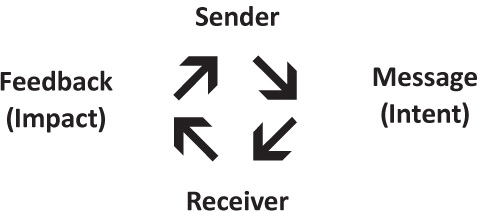
Position vs. Interest—An Exercise
Reflect on a past conflict you had in which what the other person wanted seemed to conflict with what you said you wanted. Use the following format to examine the positions and interests:
![]() Briefly describe the event.
Briefly describe the event.
![]() What was your stated position? What was it that you wanted?
What was your stated position? What was it that you wanted?
![]() Why did you take this position? Why did you want it?
Why did you take this position? Why did you want it?
![]() What were you saying no to? What activity or behavior did you want to say yes to?
What were you saying no to? What activity or behavior did you want to say yes to?
![]() What were you seeking to change? Why?
What were you seeking to change? Why?
![]() What core value(s) were you seeking to protect? Why?
What core value(s) were you seeking to protect? Why?
![]() To the best of your ability, why might they have wanted what they said they wanted? (Try to give them the benefit of the doubt rather than assuming negative motivations.)
To the best of your ability, why might they have wanted what they said they wanted? (Try to give them the benefit of the doubt rather than assuming negative motivations.)
![]() What were they saying no to? What activity or behavior might they want to say yes to?
What were they saying no to? What activity or behavior might they want to say yes to?
![]() What might they have been seeking to change? Why?
What might they have been seeking to change? Why?
![]() What core value(s) were they seeking to protect? Why?
What core value(s) were they seeking to protect? Why?
Hersey/Blanchard Situational Leadership Model
Supporting or Participating Leaders pass day-to-day decisions, such as task allocation and process, to the follower. The leader facilitates and takes part in decisions, but control is with the follower. |
Coaching/Selling Leaders still define roles and tasks, but seek ideas and suggestions from the follower. Decisions are the leader’s prerogative, but communication is much more two-way. |
Delegating Leaders are still involved in decisions and problem solving, but control is with the follower. The follower is responsible for implementation and decides when and how the leader will be involved. |
Directing/Telling Leaders define the roles and tasks of the followers and supervise them closely. Decisions are made by the leader and announced to the followers. Communication is largely one-way. |
Discovering Your Conflict Style (adapted from The Power of a Good Fight)
Competing
1. Do you enjoy the give and take of a good argument?
2. Are you competitive—even in situations where the results aren’t very important to you?
3. Do coworkers frequently give in to you because it’s too much trouble to work things out?
4. Are there some people in the organization who avoid you or fear interaction with you?
If you answered yes to two or more of these questions, your preferred style is competing.
Accommodating
1. Is loyalty one of your highest values?
2. Is it important to you to have coworkers like you?
3. Do you give in during disagreements—even if you think you have a better idea—because you believe it’s best for your team or organization?
4. Are you constantly trying to take care of the feelings of others or to make them feel better?
If you answered yes to two or more of these questions, your preferred style is accommodating.
Avoiding
1. Do you generally avoid conflict even when the issue is important to you?
2. Are you frequently unsure about where you stand on a particular issue that others seem to feel strongly about?
3. Do you avoid certain people in your organization who have abrasive or competitive styles?
4. Do you prefer to have time to think before you speak or answer questions?
If you answered yes to two or more of these questions, your preferred style is avoiding.
Compromising
1. When you’re upset with a coworker, do you feel a need to talk to someone else about the issue?
2. Does the idea of confronting someone directly with your issues intimidate you?
3. Do others at your level of the organization come to you to talk about their problems with their coworkers?
4. Do you need to talk extensively about your feelings with someone before you’re sure what you think and feel?
If you answered yes to two or more of these questions, your preferred style is compromising.
Collaborating
1. Do others frequently ask you to mediate their disputes?
2. Do you consistently step back from the emotion of a conflict and think before responding?
3. Are you able to see the big picture during disagreements?
4. Are you able to remember and consider your own goals as well as your organization’s goals during an argument?
5. Do others tell you that you are a good listener?
If you answered yes to two or more of these questions, your preferred style is collaborating.
Preparing to Mediate: A Checklist
If you’re called upon to mediate a conflict, the questions presented in this checklist can help you organize your thoughts about the problem-solving process.
People
![]() How do they see the problem?
How do they see the problem?
![]() Are emotions part of the problem?
Are emotions part of the problem?
![]() Are they having any misunderstandings?
Are they having any misunderstandings?
Interests
![]() What are the interests of each person to the conflict?
What are the interests of each person to the conflict?
![]() Can they each articulate their needs, wants, hopes, and fears?
Can they each articulate their needs, wants, hopes, and fears?
Inventing Options
![]() Have the individuals focused on options?
Have the individuals focused on options?
![]() Have they tried brainstorming?
Have they tried brainstorming?
Fairness
![]() Has each person identified standards of fairness to help address the problem?
Has each person identified standards of fairness to help address the problem?
![]() Have fair procedures been identified?
Have fair procedures been identified?
Yourself
![]() Do I have the vantage point of a neutral observer?
Do I have the vantage point of a neutral observer?
![]() Can I describe the problem in a way that rings true for all involved?
Can I describe the problem in a way that rings true for all involved?
![]() Do I understand that the individuals involved have to determine the solution?
Do I understand that the individuals involved have to determine the solution?
Employment Discrimination Laws and Related Websites
This list is not meant to be all-inclusive. There are additional federal laws, as well as state and local laws, that impact working relationships. Laws and regulations are not static, and they frequently change. The resolution of each circumstance encountered by readers should ultimately be determined on a case-by-case basis, depending upon the particular facts. Legal counsel should be sought as appropriate.
Select federal non-discrimination laws include but are not limited to:
![]() Age Discrimination in Employment Act (ADEA) and Older Workers Benefit Protection Act (OWBPA).
Age Discrimination in Employment Act (ADEA) and Older Workers Benefit Protection Act (OWBPA).
![]() Americans With Disabilities Act and the ADA Amendments Act (ADA).
Americans With Disabilities Act and the ADA Amendments Act (ADA).
![]() Employee Retirement Income Security Act (ERISA).
Employee Retirement Income Security Act (ERISA).
![]() Equal Pay Act (EPA).
Equal Pay Act (EPA).
![]() Fair Labor Standards Act (FLSA).
Fair Labor Standards Act (FLSA).
![]() Family and Medical Leave Act (FMLA).
Family and Medical Leave Act (FMLA).
![]() Genetic Information Nondiscrimination Act (GINA).
Genetic Information Nondiscrimination Act (GINA).
![]() Health Insurance Portability and Accountability Act (HIPAA).
Health Insurance Portability and Accountability Act (HIPAA).
![]() Immigration Reform and Control Act (IRCA).
Immigration Reform and Control Act (IRCA).
![]() National Labor Relations Act (NLRA).
National Labor Relations Act (NLRA).
![]() Occupational Safety and Health Act (OSHA).
Occupational Safety and Health Act (OSHA).
![]() Patient Protection and Affordable Care Act (ACA).
Patient Protection and Affordable Care Act (ACA).
![]() Pregnancy Discrimination Act (PDA).
Pregnancy Discrimination Act (PDA).
![]() Title VII of the Civil Rights Act of 1964 and the Civil Rights Act of 1991 (Title VII).
Title VII of the Civil Rights Act of 1964 and the Civil Rights Act of 1991 (Title VII).
![]() Uniformed Services Employment and Reemployment Rights Act (USERRA).
Uniformed Services Employment and Reemployment Rights Act (USERRA).
Related Websites
![]() Equal Employment Opportunity Commission (www.eeoc.gov).
Equal Employment Opportunity Commission (www.eeoc.gov).
![]() ADEA; OWBPA; ADA; EPA; GINA; PDA, Title VII.
ADEA; OWBPA; ADA; EPA; GINA; PDA, Title VII.
![]() Department of Labor Wage and Hour Division (www.dol.gov/whd).
Department of Labor Wage and Hour Division (www.dol.gov/whd).
![]() FMLA; FLSA.
FMLA; FLSA.
![]() Department of Labor Employee Benefits Security Administration (www.dol.gov/ebsa).
Department of Labor Employee Benefits Security Administration (www.dol.gov/ebsa).
![]() ERISA; HIPAA; ACA.
ERISA; HIPAA; ACA.
![]() Department of Labor (www.dol.gov/compliance/laws/comp-osha.htm).
Department of Labor (www.dol.gov/compliance/laws/comp-osha.htm).
![]() OSHA.
OSHA.
![]() Department of Labor Veterans Employment and Training Services (www.dol.gov/vets).
Department of Labor Veterans Employment and Training Services (www.dol.gov/vets).
![]() USERRA.
USERRA.
![]() National Labor Relations Board (www.nlrb.gov).
National Labor Relations Board (www.nlrb.gov).
![]() NLRA.
NLRA.
![]() United States Citizenship and Immigration Services (www.uscis.gov).
United States Citizenship and Immigration Services (www.uscis.gov).
![]() IRCA.
IRCA.
Spiral of Disrespect
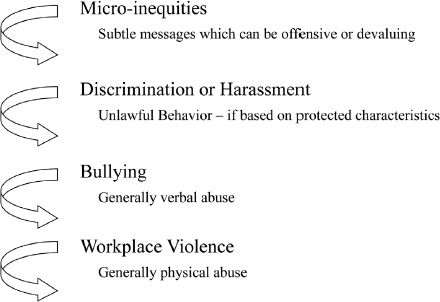
Preventing Harassment—Managers’ Guide
Although some of the information in this guide is specific to workplace harassment, it can serve as guiding principles for preventing other types of disruptive workplace behavior. Follow your organization’s policies and enforce the policies and the rules.
![]() Immediately document observed or reported incidents of harassment.
Immediately document observed or reported incidents of harassment.
![]() Notify human resources immediately.
Notify human resources immediately.
If an employee says that he or she will handle the incident and does not want you to disclose it, you must advise that this is not an option. (The organization is obligated to investigate once it has knowledge of the alleged discrimination/harassment.)
![]() Remain neutral. Do not take sides.
Remain neutral. Do not take sides.
![]() Maintain confidentiality.
Maintain confidentiality.
Set a positive tone and example through your own actions and behaviors.
![]() Be mindful of behavior, language, and social interactions.
Be mindful of behavior, language, and social interactions.
![]() Be respectful of others’ personal space.
Be respectful of others’ personal space.
Be open to discussing the issue of harassment or other types of disruptive behaviors.
![]() Distribute copies of the policies when requested by management.
Distribute copies of the policies when requested by management.
![]() Remind employees that discriminatory/harassing behaviors or remarks, or any other disrespectful behaviors or remarks, do not belong in the workplace.
Remind employees that discriminatory/harassing behaviors or remarks, or any other disrespectful behaviors or remarks, do not belong in the workplace.
Be actively alert for inappropriate workplace behavior. Treat it seriously.
![]() Act quickly. Don’t put it off.
Act quickly. Don’t put it off.
![]() Address improper conduct if you see it happening.
Address improper conduct if you see it happening.
![]() Don’t ignore it; it won’t go away.
Don’t ignore it; it won’t go away.
![]() Remember that, as a supervisor, if you knew or should have known of conduct that potentially could be harassment or discrimination, the company is liable to show that immediate and appropriate corrective action was taken.
Remember that, as a supervisor, if you knew or should have known of conduct that potentially could be harassment or discrimination, the company is liable to show that immediate and appropriate corrective action was taken.
Workplace Harassment—Employee Rights & Responsibilities
You have the right to work in an environment free from harassment or other disruptive behavior. Along with that right, goes the responsibility to assure your rights and those of your coworkers are protected. Though some of the information in this guide is specific to workplace harassment, it can serve as guiding principles for preventing other types of disruptive workplace behavior.
![]() Be an up-stander, not a by-stander. Speak up against potentially offensive and disruptive behavior. Even if you are an impartial observer, you have the right and responsibility to speak up.
Be an up-stander, not a by-stander. Speak up against potentially offensive and disruptive behavior. Even if you are an impartial observer, you have the right and responsibility to speak up.
![]() Describe the behavior that offends you.
Describe the behavior that offends you.
![]() Explain the impact. Provide enough information so the offender understands the impact of the behavior on you and others.
Explain the impact. Provide enough information so the offender understands the impact of the behavior on you and others.
![]() Let the individual know that the behavior is unwanted and you are asking for it to stop.
Let the individual know that the behavior is unwanted and you are asking for it to stop.
![]() If someone finds your behavior offensive or disruptive, don’t get defensive. Listen for understanding and clarity.
If someone finds your behavior offensive or disruptive, don’t get defensive. Listen for understanding and clarity.
![]() If the behavior continues, report it according to company policy.
If the behavior continues, report it according to company policy.
![]() Be sensitive to the feelings, values, opinions, and attitudes of fellow employees.
Be sensitive to the feelings, values, opinions, and attitudes of fellow employees.
![]() Recognize that harassment, sexual or otherwise, is seen through the eye of the beholder.
Recognize that harassment, sexual or otherwise, is seen through the eye of the beholder.
![]() Do not assume that coworkers enjoy hearing comments about their appearance, stories about your “love life,” being touched, propositioned, or subjected to jokes of a sexual nature.
Do not assume that coworkers enjoy hearing comments about their appearance, stories about your “love life,” being touched, propositioned, or subjected to jokes of a sexual nature.
![]() Document details of incidents, including time, place, circumstances, and witnesses.
Document details of incidents, including time, place, circumstances, and witnesses.
![]() Offer support to victims and intervene on their behalf.
Offer support to victims and intervene on their behalf.
![]() If you have any doubts about your own conduct, ask yourself: “Is it respectful?” Remember that respect is also in the eye of the beholder.
If you have any doubts about your own conduct, ask yourself: “Is it respectful?” Remember that respect is also in the eye of the beholder.
Sample Conflict Resolution Policy
Here is what you might want to include in a conflict resolution policy (not intended to be all-inclusive):
Purpose of the policy
Problems, misunderstandings, and frustrations may arise in the workplace. It is [insert organization’s name]’s intent to be responsive to its employees and their concerns. The purpose of this policy is to provide a quick, effective, and consistently applied method for a nonsupervisory employee to present his/her concerns to management and have those concerns internally resolved. Therefore, if you are confronted with a problem, you may use the following procedure to resolve or clarify your concerns.
Procedures
Step 1. Discuss with supervisor.
Initially, you should bring your concern or complaint to your immediate supervisor. If the complaint involves your supervisor, you should meet with his/her supervisor to discuss the problem within five days of the date the incident occurred.
The supervisor should respond in writing to you within five days of the meeting.
Step 2. Written complaint and decision.
If the discussion with your supervisor (or his/her supervisor) does not resolve the problem to the mutual satisfaction of you and the supervisor, or if the supervisor does not respond, you may submit a written complaint to your department’s director or vice president. You may request help from Human Resources to write your complaint if needed. The director or vice president should forward a copy of the complaint to Human Resources.
The complaint should outline the problem and the date it occurred, suggestions on how to resolve the issue, and the response from the supervisor along with the date you met with the supervisor.
Upon receipt of the formal complaint, the director or vice president must schedule a meeting with you within five business days and should issue a decision within five days of the date of the meeting.
Step 3. Appeal of the decision.
If you are not satisfied with the decision of the director or vice president, you may, within five business days, appeal the decision in writing to the HR Department.
The HR Department may call a meeting with everyone involved to facilitate a resolution or may refer the complaint to a review committee.
The parties involved in the complaint should refrain from discussing it with anyone with the exception of the HR Department, in order to preserve the integrity of any investigation that may be necessary.
If an employee fails to appeal from one level to the next level of this procedure within the time limits previously set forth, the problem will be considered settled on the basis of the last decision and the problem will not be subject to further consideration.
[Organization name] reserves the right to impose appropriate disciplinary action for any conduct it considers to be disruptive or inappropriate. The circumstances of each situation may differ, and the level of disciplinary action may also vary depending on factors such as the nature of the offense, whether it is repeated, the employee’s work record, and the impact of the conduct on the organization.
No employee will be subject to retaliation for filing a complaint under this policy.
